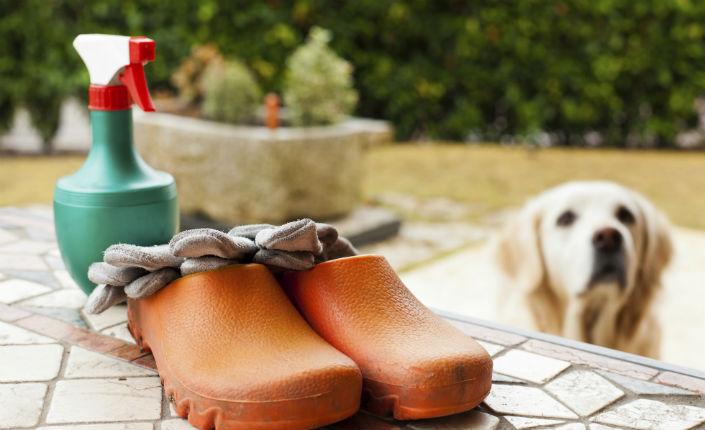
Clean Up Your Yard for Spring – and Your Pet’s Safety
As pet owners, we know it’s officially spring the day we let our dog outside for a bio-break and he's not right back jumping at the door in a few freezing cold seconds. Or when he comes back into the house with something wet and slimy (hopefully only mud) on his paws that’s been covered up for most of the winter.
As warmer weather arrives each spring across Canada, it opens up parts of our yards that may have been buried under a deep layer of snow – or that we and our pets just chose to ignore all winter due to the cold. Beyond the obvious items, like (ahem) scooping up what your dog did in the backyard this winter, there are some often overlooked clean-ups to consider to make your yard pet-safe this spring.
Decks & stairs
There may be areas on your deck or stairs that are not exposed during the spring or summer because the space is occupied by a barbeque or plant. These ‘hidden’ areas may expose your pet to injury or illness if they get into or under them.
Fallen branches can scratch and damage a pet’s eyes, so make sure yard clean-up includes picking branches up, early in the spring.
Nests of squirrels, mice or rabbits (and their droppings) can be very smelly and tempting. Have a look around and eliminate them if you can.
Small items, such as rusted bottle caps, nails and even cherry pits can fall through the gaps in your deck boards, creating potential hazards for pets who wriggle underneath.
And of course, there’s always the potential that once a pet does get underneath the deck, they’ll panic, or just become trapped and unable to get back out. It’s best to seal any cracks off as soon as you see an opening.and you get the picture. Seal any cracks off as soon as you see an opening.
Fences & gates
Your fencing can become damaged, either from exposure to the elements over time, during shoveling, or even from the use of heavy snow removal equipment along your back lane. This damage can create openings where pets can get through, or expose raw edges that can cut, scrape or leave behind splinters. Each spring conduct a thorough walk around the perimeter of your yard to inspect your fence and gates – inside and out – to make sure they’re structurally sound and that any moving parts are in good working order. If you have to, pet-proof them temporarily by sealing any holes and broken boards with thick plastic, duct tape or plywood until you can properly repair them.
Ground shifts
Sometimes, during slower spring melts, up-and-down temperatures and continual freezing and thawing can cause the ground in your yard to shift. Similarly, during heavy spring rains, sections of earth can be washed away around your fence line. This can expose gaps and areas where small pets can escape, or larger dogs can dig at and break free over time. If this has happened in your yard, visit your hardware store to pick up small sections of metal fencing or plastic garden edging that can be pushed into place, sealing the breach until you can once again raise and level the ground along your fence with earth or gravel.
Growth spurts
Has your dog grown since last fall? If so, he might be able to climb or jump on structures that he couldn’t reach last year. Many a Border Collie has cleared a fence by jumping on a small shed or garden bench he couldn’t reach the previous year when he was a pup. Items placed temporarily near a fence in the fall for storage will also need to be moved away as soon as possible.
The old glove-&-garbage-bag treatment
Don a pair of work or rubber gloves and roam your yard looking for that rotting pumpkin you left outside to freeze over Halloween, old toys that may have become mouldy or any other garbage that may have collected. It wouldn’t be good for pets to eat, and we all know how dogs love to chew things that smell interesting. If you live on a corner or near a crosswalk or sidewalk, garbage and other items can be thrown over your fence during the winter by passers-by. The remains of birds and rodents may also be left behind, attracting vermin – as well as your pet’s interest – as the temperature rises. If your dog worries away at a rotting carcass, he can become very sick. Be sure to inspect around low shrubbery and landscaping rocks, as well as in raised or lowered beds in your garden, and remove any animal remnants immediately (wearing disposable gloves and a Medi-Mask, if possible).
